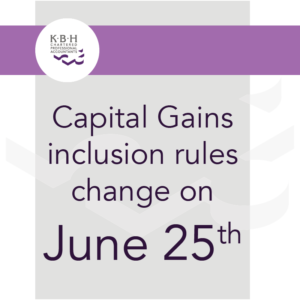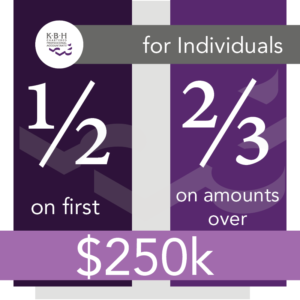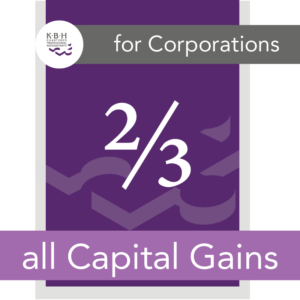2024 Federal Budget Changes in Tax on Capital Gain: What They Mean to “Rich” and “Regular” Canadians
This article was originally written by Anna Malazhavaya of Advotax Law, and has been adapted with the author’s permission. The Ontario numbers/examples have been replaced with Albertan stats.
 This article aims to explain the Changes implied in the federal budget for taxable capital gains for the year 2024. Through its sections, it will give insights how these changes will impact the high and middle income Albertans. This is a case study about several Alberta investors who hold similar assets with identical accrued capital gains.
This article aims to explain the Changes implied in the federal budget for taxable capital gains for the year 2024. Through its sections, it will give insights how these changes will impact the high and middle income Albertans. This is a case study about several Alberta investors who hold similar assets with identical accrued capital gains.
Until June 25, 2024, their tax treatment would have been similar, but after June 25, 2024 it will differ quite significantly. The difference in tax will not be based on the investors’ ability to pay.
In the April 16, 2024 Budget Announcement, the Canadian Federal Government proposed an increase to the capital gain inclusion rate for gains realized on or after June 25, 2024 as follows:

- for individuals, capital gain up to $250,000 will be subject to the current inclusion rates (one half), but capital gain in excess of $250,000 will be subjection to the new inclusion rates (two thirds);
- for corporations and trusts, all capital gain will be subject to the new inclusion rates (two thirds).
 The proposed rules favour personal ownership vs. corporate ownership and encourage joint ownership with family members. On June 25, 2024, the affected taxpayers will see an overnight tax hike of up to a staggering 8 percent, from the current maximum effective tax rate of up to 24% to ~32% in Alberta.
The proposed rules favour personal ownership vs. corporate ownership and encourage joint ownership with family members. On June 25, 2024, the affected taxpayers will see an overnight tax hike of up to a staggering 8 percent, from the current maximum effective tax rate of up to 24% to ~32% in Alberta.
Real Estate Investors: Joint Owner Joe, Single Owner Sandra, Corporate Cam
Joe, Sandra and Cam are real estate investors in their 60s. Just like 4.4M other Canadians, they invested in a real estate property to save for a retirement. All live in Alberta, all are married, employed full-time, and earn $100,000/year. The three couples are comfortable financially, but it’s hard to call them “rich” given Alberta’s rising cost of living.
In 2009, the three couples borrowed money to purchase three side-by-side identical townhouses in Edmonton, AB for $400,000 each. All six worked extra hard, saving every penny to pay off the mortgage loans. Luckily, their townhouses grew in value by $500,000 over the last 15 years and are worth $900,000 now. The three couples now wish to dispose of their properties to pay for their retirement.
Until June 25, 2024, the couples’ tax exposure from the sale of the townhouses would have been roughly similar, ranging from $96,000 to $115,000.
Starting from June 25, 2024, the couples’ tax liability from the sale of their townhouses will differ quite drastically from $96,000 to $158,000 depending on the how they chose to hold their property when they purchased it 15 years ago.
Joint Owners Joe and Jill: $96,000 in Tax, not Affected by Proposed Rules
Joint Owner Joe is married to Jill. Like Joe, Jill earns a salary of $100,000/year. Both Joe and Jill are the owners of the townhouse. They listed the townhouse for sale and found a buyer. The buyer is asking for a June 25, 2024 closing date. Joe and Jill together will realize $500,000 in capital gain, but each of them will realize $250,000, which will still be subject to tax under the old inclusion rates.
If Joe and Jill close the sale on before June 24, 2024, before the proposed rules are supposed to take effect, each of them will pay approximately $48,000 each in tax in 2024: $42,800 on their salaries and $96,000 on capital gain. Overall, the sale of the townhouse will result in $96,000 tax for Joe and Jill’s family.
If Joe and Jill close the sale on or after June 25, 2024, after the proposed rules are supposed to take effect, their tax liability will not change.
Sole Owner Sandra: Tax Increase from $106,000 to $126,000
Sole Owner Sandra is married to Sam. Like Jill in the example above, Sam earns a salary of $100,000/year. Although the couple share finances, Sandra is the sole owner of the townhouse. Sandra listed the townhouse for sale and found a buyer. The transaction closes on June 25, 2024. Sandra will realize $500,000 in capital gain. Only $250,000 will be subject to tax at the “old” inclusion rates, but the remaining $250,000 will be subject to the new inclusion rates.
If Sandra closes the sale on or before June 24, 2024, she will pay approximately $127,000 in tax in 2024: $21,400 on her salaryand $105,600 on capital gain from the sale of her townhouse. If Sandra closes the sale on or after June 25, 2024, she will pay approximately $147,000 in tax in 2024: $21,400 on her salary and $125,600 on capital gain from the sale of her townhouse.
Corporate Cameron: Tax Increase from $136,000 to $179,000
Corporate Cameron wanted an additional limited liability protection when he was purchasing the townhouse in 2009. This is why he purchased the townhouse through a newly created holding corporation, CameronCo. CameronCo listed the townhouse for sale and found a buyer. The transaction closes on June 25, 2024. Once sold, CameronCo will pay out the proceeds as dividends to Cameron and dissolve.
CameronCo will realize $500,000 in capital gain. All $500,000 will be subject to tax at the “new” inclusion rates.
If CameronCo closes the sale on or before June 24, 2024, Cameron and CameronCo together will pay approximately $136,000 in tax related to the sale of the townhouse ($40,000 corporate and $96,000 in personal tax). If CameronCo closes the sale on or after June 25, 2024, Cameron and CameronCo together will pay approximately $179,000 in 2024 ($53,000 in corporate and $126,000 in personal tax).
Early Earl and Late Liam: Tax Increase from $201,000 to $261,000
If you think Cameron is unlucky, consider the example of Early Earl and Late Liam. Earl and Liam are both 120 years old and are unfortunately, quite unwell. Both held their lifetime savings – an investment portfolio with $1,000,000 accrued gain. Sadly, Earl passed away on June 24 2024, and Liam passed away on June 25, 2024. Earl’s terminal return tax liability will be approximately $201,000 in tax, but Liam’s – ~$261,000.
Conclusion
The proposed tax hike will have significant impact on many regular Canadians, especially those with retirement savings that must be realized all at once (either through a real disposition by way of a sale or a gift, or through a deemed disposition triggered by an emigration or death).
Without proper planning, at midnight on June 25, 2024, these Canadians’ tax exposure may increase significantly, sometimes disproportionately to other Canadians with the same or better ability to pay.
These affected Canadians have only 2 weeks left to obtain tax advice from their tax professionals, but the relevant draft legislation is not even available.
Canadians who hold their savings in investment portfolios, even the “richest” ones, will generally have control over how much capital gain they trigger every year (more than $250,000 or less) and will be less affected by the proposed rules. More planning opportunities will be available to them as opposed to real estate investors.
Important Disclaimer
The amounts used in this blog are to give a general idea of the impact of the change in capital gains. If you have specific questions about what the numbers would look like for you, please reach out to us at Info@kbh.ca.
The case studies in this article are based on the general language used in the Budget announcement and not on the actual legislation, which is not available as of today, June 13, 2024. The proposed legislation must pass in the House of Commons and the Senate before it becomes the law.
Additional Clarification:
The Finance Minister has released a Notice of Ways and Means Motion that includes draft legislation for the capital gain inclusion increase that have answered a few questions:
– No ability to elect to internally trigger capital gains in anticipation of the June 25 deadline.
– You will have to complete a transaction to trigger the gain.
– No ability to average capital gains over multiple years to stay under the $250,000 threshold.
– If you don’t use your $250k threshold one year, it does not carry over to the next year.
– No ability to split the $250,000 threshold with corporations.
– A corporation is subject to the 2/3 inclusion rate on the first $1 of capital gain realized.
– No exceptions for specific assets or types of corporations.
– It does not matter what asset the gain is realized on, the inclusion rate will be 2/3 for transaction on or after June 25, 2024.
When a capital gain is realized, you can claim a reserve if you don’t collect all the proceeds right away. The reserve is limited so that 20% of the gain must be included in income each year at minimum (or 10% if the asset sold is farmland to a child).
Any reserves claimed are considered to be taxable income on the 1st day of the following taxation year which means that a capital gain realized before June 25, 2024 which would have had a 1/2 inclusion rate may be subject to the 2/3 inclusion rate.
However, CRA has released background information for the increase in the inclusion and they have stated that the $250k threshold would apply to reserves brought into income in the year.
The capital gain exemption is increasing to $1,250,000 as of June 25, 2024. The capital gain inclusion will offset a full gain of $1,250,000. If you use a portion of the capital gain exemption, the remainder will be calculated based on the gross gain reported (it will not matter if the inclusion rate was ½ or 1/3).
